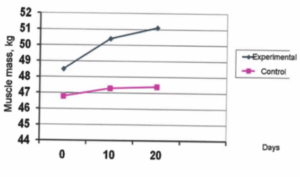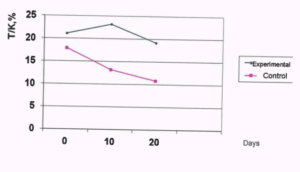
The study has been performed during the period: from May 2019 to August 2019, in accordance with the planned training process of sportsmen in speed and endurance sports (throwing and all-around), as well as in the endurance all-around. The structure of training in these terms was represented by a mesocycle lasting four weeks micro cycles (on days 3.5 training + 0.5 recovery + 2.5 training + 1.5 rest). The volume and intensity of physical activity corresponded to the stage of special training of the annual cycle.
The experimental test team was made up of athletes-throwers, all-around athletes, powerlifters, triathletes, football players, and hockey players. Below are the composition and characteristics of the experimental group of testers:
Characteristics of the test team and the terms of research for various sports
| Kind of Sport | Amount of Sportsmen | Term/Duration |
|---|---|---|
| Track & Fields | 8 | 2018 (2 months) |
| Triathlon | 6 | 2019 (5 weeks) |
| Games (Soccer, Ice Hockey) | 12 | 2019 (5 weeks) |
| Endurance (Powerlifting, Weightlifting) | 12 | 2018 (2 months), 2019 (2 weeks) |
| Total | 38 |
These characteristics of the test team indicate that highly qualified sportsmen represented the experimental group with specialization in speed and endurance sports.
The testers were randomly divided into the experimental and control groups as follows: 6 sportsmen in each group (3 throwers, 2 all-rounders, and 1 powerlifter) and 4 sportsmen in each group (football and hockey players). According to the manufacturer’s recommendations, sportsmen in the experimental group have been receiving BCAA IPH AGAA daily, ingested in 3-gram doses before and after each physical activity for four weeks of the training camp. In the control group, sportsmen have been receiving the standard medicine BCAA according to the same scheme at a dose of 10 grams. Taking other medications was excluded in both groups.
Testing of speed and strength indicators, morphological, and biochemical control of sportsmen’s condition was carried out three times during the experiment: before the beginning, after two weeks, and at the end of the experiment. During the experiment, sportsmen from the experimental group underwent out-of-competition doping testing (4 from the experimental group and 3 from the control group).
The obtained experimental data were statistically processed based on the Wilcoxon distribution for small samples. The T-test and the corresponding levels of significance of differences were determined using a standard computer program.
The effect of the medicine on the body’s adaptation to training physical activity was assessed. The adaptation of the organism to the training physical activity during the training stage and its tolerability were assessed by morphological and biochemical criteria of the sportsmen’s current control condition.
The effect of the medicine on the body’s morphological characteristics was also examined. A comparative study of labile components’ dynamics in the sportsmen’s body composition in both the experimental and control groups during the experiment was performed. Testers in the experimental group received BCAA IPH AGAA daily for 4 weeks according to the scheme. Testers in the control group received standard BCAA at the same time and under a similar scheme for comparison.
The effect of BCAA IPH AGAA on the sportsmen’s morphological characteristics was evaluated by analyzing the dynamics of body weight (BW), muscle mass (MM), and fat mass (FM) in the experimental group compared to similar indicators in the control group. Caliperometry measuring the thickness of skin-fat folds and the calculation of appropriate indicators MM and MT, produced by the method “Matejko” in modification by Abramova T.F. [2010], were conducted at the beginning of each of the four microcycles during the experiment.
It was found that under conditions of increased training physical activity during this preparation period, the course of BCAA IPH AGAA led to a significant increase in the absolute and relative indicators of the throwers’ muscle mass compared to the initial values (table 1). According to external indicators, the dynamics of body composition’s labile components have been expressed in a significant increase in the anatomical relief of the ratio of muscle and fat layers. In the control group, after the course of medicine reception of the comparison standard BCAA, the increase in the body weight of testers measured by caliperometry test examination was mainly due to a significant increase in fat mass, while indicators of muscle mass did not significantly change (table 1). Therefore, it can be concluded that BCAA IPH AGAA, unlike the standard medicine BCAA, taken in smaller doses during increased levels of speed and strength physical activity in the training phase, has a significantly expressed anabolic effect on the muscle mass of sportsmen, accompanied by an increase in body mass (figure 1). Additionally, sportsmen in the experimental group experienced an increase in anatomical relief.
Dynamics of labile components of body composition in the experimental and control groups before and after the experiment, with mean values (M) and standard errors of the mean (m):
| Indicator | Before Experiment (Experimental) | Before Experiment (Control) | After Experiment (Experimental) | After Experiment (Control) |
|---|---|---|---|---|
| Body Weight (BW), kg | 94.0±2.2 | 92.2±3.2 | 92.4±1.8 | 91.5±1.6 |
| Muscle Mass (MM), kg | 48.6±1.4 | 46.9±1.8 | 50.9±1.4* | 47.2±1.6* |
| Muscle Mass (MM), % | 51.6±0.8 | 50.0±0.8 | 52.8±0.6* | 50.5±0.6* |
| Fat Mass (FM), kg | 13.9±1.0 | 14.8±1.2 | 13.0±1.4* | 14.4±1.0 |
| Fat Mass (FM), % | 14.7±0.6 | 15.5±1.6 | 13.2±0.8* | 15.0±1.8 |
*Statistically unreliable differences compared to the original values (p>0,05)
Figure 1-Comparative indicators* dynamics of sportsmen muscle mass in experimental and control groups.

In this research, a comparative assessment of the sportsmen’s dynamics of adaptation to training activity at the stage of special training during the use of BCAA IPH AGAA has been performed. The assessment was carried out based on the results of determining the levels of testosterone (T) and cortisol (K) in blood and their ratio (T/K) in accordance with the standard program of current biochemical control of the sportsmen.
It was found that as a result of the use of the amino acid complex BCAA IPH AGAA in the experimental testers’ group, by the end of the special training stage, there were no significant changes in the hormonal coefficient of adaptation T/K compared to the initial values (p > 0.05). In the control group, where testers had been receiving the standard BCAA at the same time, there was a significant decrease in this coefficient from 0.18 to 0.11 (p < 0.05) (table 2, figure 2).
Dynamics of Testosterone and Cortisol levels and their ratio in ther bIood of sportsmen in the experimental group at the special training stage M±m
| Indicators | Before the Beginning (Experimental) | Before the Beginning (Control) | After Experiment (Experimental) | After Experiment (Control) |
|---|---|---|---|---|
| Testosterone, nm/1 | 28.9±3.7 | 25.2±5.2 | 29.9±4.0* | 16.3±2.1 |
| Cortisol, nm/1 | 141±16.2 | 137±17.4 | 179±11.0 | 281±10.8 |
| Adaptation Coefficient (T/K) | 0.21±0.04 | 0.18±0.04 | 0.18±0.06* | 0.11±0.01* |
*Statistically unreliable differences compared to the original values (p>0,05)

Figure 2-Comparative assessment of the degree of throwers’ adaptation in the experimental group during the1st base period of training.
Thus, the control of the sportsmen’s state at the stage of special training revealed a higher degree of body adaptation to the appropriate training activity during the taking of the medicine BCAA IPH AGAA. This effect of the studied medicine is evidenced by the data on the comparative dynamics of morphological characteristics of sportsmen’s muscle mass and the biochemical coefficient of adaptation T/C in the experimental and control groups of testers.
The effect on speed and strength indicators of sportsmen. Testing of speed and strength indicators of testers in the experimental group was carried out by defining the corresponding indicators according to the generally accepted standard program. This program included four speed and strength tests: running at 30 meters from the move, jump from the spot, triple jump, and throwing the ball with two hands from the bottom forward. Additionally, one strength test, bench press testing, was carried out twice – before and after the special training stage.
After statistical processing of the obtained data, a comparative assessment of the level of speed and strength has been performed on testers in the experimental and control groups based on these indicators over the last stage of training. During the course of receiving the medicine BCAA IPH AGAA in the testers in the experimental group, a significant increase has been recorded in all tested indicators of the level of sportsmen’s speed and strength training compared to the initial values (table 3). The greatest increase was noted in bench press (+9.5%), shot forward with two hands (+9.2%), and triple jump (+10%) (table 3). In the control group of testers who at the same time received the standard BCAA as a comparison medicine, the level of development of speed and strength indicators at this stage of training was lower. Two indicators (30 meters running and long jump) did not change significantly (p > 0.05), and the increase in the remaining tests was lower compared to similar values in the experimental group – respectively, in the bench press +5.2%, throw forward with both hands +1.5%, and triple jump +2.6% (table 3).
Dynamics of speed and strength indicators of throwers and power lifters in experimental group during the 1st basic training period, M±m
| Indicators | Before the Beginning (Experimental) | Before the Beginning (Control) | After Experiment (Experimental) | After Experiment (Control) |
|---|---|---|---|---|
| Running at 30 meters, sec | 3.81±0.02 | 3.87±0.04 | 3.77±0.01* | 3.86±0.04* |
| Jump from the spot, m. | 2.70±0.20 | 2.72±0.08 | 2.80±0.12 | 2.73±0.23* |
| Triple jump, m. | 8.52±0.22 | 8.64±0.32 | 9.24±0.11* | 8.92±0.09 |
| Throw the ball with two hands | ||||
| from the bottom forward, m.** | 16.72±0.80 | 16.56±0.36 | 17.25±0.64 | 16.80±0.27 |
| Bench press, kg | 90.5±4.5 | 85.5±2.5 | 95.5±4.5 | 90.0±2.5 |
*Statistically unreliable differences compared to the original values (p > 0.05) ** 6 kg or 5 kg (depending on the sportsmen’s age)
Based on these data, we can conclude that at the stage of development of speed and strength indicators, the amino acid complex BCAA IPH AGAA has a more pronounced effect on speed and power (running 30m, jumping, and throwing the core bottom) and strength (bench press) of all-rounders and power lifters compared to the standard medicine BCAA.
The effect of course admission IPH-BCA AGAA on indicators of explosive strength of football players’ legs in the jump tests, (M±m)
| Test | Before the Course (Experimental) | Before the Course (Control) | After the Course (Experimental) | After the Course (Control) |
|---|---|---|---|---|
| Vertical jump-up from the | 78±4.8 | 81±3.6 | 84±2.2 | 83*±1.8 |
| spot (cm) | ||||
| Long jump from the spot (m) | 2.48±0.14 | 2.44±0.04 | 2.68±0.16 | 2.56±0.22 |
The experiment was conducted in the basic training period of football players on the stage of development OFP/SFP for 18 days. Testers in the experimental group received IPH BCAA AGAA orally daily in a dose of 2 capsules during a meal; in the control group, sportsmen received a standard BCAA medicine without peptides according to the generally accepted scheme of 4 capsules before and after training. During testing, the average value of the result of three consecutive attempts performed with an interval of 30 seconds was recorded. The obtained results were processed statistically according to the Student-t criterion for small samples.
The course of IPH BCAA AGAA for 18 days significantly increased the performance of explosive leg strength in both jumping tests (vertical and horizontal). In the vertical jump up, in the control group, there was no significant change in the test index after the course of taking the standard BCAA medicine during the training camp. In contrast to the control, in the experimental group of football players who received the BCAA IPH AGAA at the same time, the result increased by 8 cm, i.e., by 7.1%. In the long jump from the spot, the increase of the sportsmen in the experimental group was 20 cm, which was 8.5% (p < 0.05). In the control group, there was also an increase in the horizontal jump, but the magnitude of the increase achieved in the same period of training was almost half, at 4.8%.
Thus, based on the experimental data obtained, it can be concluded that BCAA IPH AGAA has a positive effect on the explosive power of football players’ legs. This effect is more pronounced compared to the similar effect of a standard BCAA medicine without a peptide component. At the same time, the dose of IPH BCAA AGAA was lower compared to the standard comparison medicine.
In general, comparing the results of the experimental study of IPH BCAA AGAA’s action on the sportsmen’s physical qualities specializing in various sports, we can make the conclusion about the positive effect of the studied medicine on speed and strength qualities. In this case, IPH BCAA AGAA is more effective than the standard BCAA medicine, which does not contain a peptide.
Anti-doping security: The conclusion on anti-doping safety of BCAA IPH AGAA is based on data on the officially registered compound of the medicine and the results of doping control of testers from the experimental group as part of the planned out-of-competition testing of sportsmen during the experiment.
In accordance with the accepted classification based on the declared composition, this medicine belongs to specialized products designed to enrich the diet of sportsmen with essential amino acids. All the components listed as part of BCAA IPH AGAA are not included in the WADA list of prohibited or restricted substances or methods for use in sports, and they do not exhibit any doping activity.
Results of doping control:
As part of this study, out-of-competition testing was conducted on a group of sportsmen, including testers from the experimental group who were taking BCAA IPH AGAA. This planned testing took place during the training camp to prepare for the opening season’s competition.
All the biological tests obtained from the testers in the experimental group who were taking BCAA IPH AGAA tested negative, indicating the absence of any traces of performance-enhancing substances.
Based on the provided data, the following conclusions can be made: